Brief Summary
provided by IABIN
Diagnosis Adults have the toes free of webbing or lateral fringes, one or two pairs of distinct dorsolateal folds, a light stripe on the lower portion of the posterior face of the thigh, and the sole of the foot covered with obvious light tubercles. Usually has tubercles on the posterior tarsus.
- author
- Esteban O. Lavilla
- editor
- Diego Arrieta
Distribution
provided by IABIN
Chacoan regions of Argentina, Bolivia and Paraguay and central Brazil.
- author
- Esteban O. Lavilla
- editor
- Diego Arrieta
Molecular Biology
provided by IABIN
princípio amargo, óleo essencial, mucilagem, sais minerais, tanino, vitanina B1(1)
Diagnostic Description
provided by IABIN
Adult morphology Adult males are of moderate size (38-46 mm). females (39-49), the head is not as wide as long, and the hind limbs are moderate in length. Male vocal sacs are modestly expanded laterally and are usually at least moderately darkly pigmented. Male forearms are not hypertrophied. Males lack asperities on the thumbs and chest. Two distinct pairs of dorsolateral folds (incated by dark/light outlining in indifferently preserved specimens) are present: one pair extends from behind the eye at the level above thc posterior edge of the tympanum to the upper groin, and a second pair extends from the top of the tympanum level, posterior to the parotoid gland, to the groin along the flanks. The toe tips are rounded or very slightly swollen. The toes generally lack fringes or lateral fleshy ridges; some individuals have vestigial basal lateral ridges and toe webbing between toes I, II and III. The upper shank is usually smooth, rarely with weak longitudinal folds. The outer tarsus usually has at least one or two to many white tubercles, but is smooth in some individuals. The sole of the foot has many or scattered white fleshy tubercles. The upper lip has a distinct (77%) or indistinct (23%) light stripe. No dark suborbital bar is present. An interorbital bar is irregularly shaped. The dorsum ranges from almost uniform tan/brown lo a pattern of parallel series of small darker spots. which may be coalesced longitudinally in some individuals, or to one or two small chevrons in the mid-scapular and mid-sacral regions. The dorsolateral folds are usually highlighted by a distinct light pin-stripe, more so posteriorlv than anteriorlv. The upper pair of dorsolateral folds is usually bordered below by a noticeably darker stripe, which is sometimes quite broad. The species lacks light middorsal stripes. The belly is immaculate or with a few indistinct dark spots or mottling on its lateralmost extent. The posterior thigh surfaces have distinct light horizontal stripes on their lower aspects. The dorsal surface of the shank has irregularly shaped crossbands. Larval morphology Body ovoid in dorsal view and ovoid/depressed in lateral view. Snout rounded in dorsal and lateral views. Eyes relatively small and dorsolaterally directed. Nostril small, dorsal, and ovoid, with laterally directed aperture. Spiracle sinistral, long, and narrow, with free distal edge. Centripetal wall of the spiracle tube fused to body wall, spiracular opening directed posterodorsally on the middle of the body. Vent tube long, medial, attached to the ventral fin, with medial directed opening. The lateral line system is visible, mainly the middle body line. Oral disc ventral, laterally emarginated. A single row of marginal papillae (8-10 papillae) is on either side of a wide anterior gap; ventral marginal papillae in double row. Papillae long, simple, and digitiform. Tooth row formula 2(2)/3(1); A-1 and A-2 rows subequal in length, P-1 and P-3 slightly shorter than P-2; A-2 interrupted medially by a gap approximately eight to ten labial teeth wide, P-1 interrupted medially by a gap two to three labial teeth wide; in four tadpoles, mean tooth density per millimeter in row A-2 75.7 ± 10.2 (67-90). Labial teeth dark, slightly curved toward the oral opening. Jaw sheaths heavy, darkly pigmented; upper sheath slightly M-shaped and the lower V-shaped; individual serration triangular. Caudal muscle robust, higher than dorsal fin along the anterior third of the tail. Dorsal fin low, weakly convex, originating on the posterior third of the body; ventral fin narrower than dorsal fin at the mid portion of tail. Coloration: Preserved specimens with body uniformly brown; ventrally transparent. Caudal muscle with small brown dots irregularly distributed, sometimes forming a medial line in the first half part of tail. Fins transparent, with slight reticulation formed by blood vessels and with some small brown dots on dorsal and ventral fins. In life, coloration is very similar to that of preserved tadpoles. Tadpole measurements (mm): Mean ± SD (range) of 10 specimens at Gosner (1960) developmental stage 35-36: total length 21.57 ± 1.30 (19.6-24.1); body length 8.35 ± 0.46 (7.6-9.1); tail length 13.12 ± 0.91 (11.5-14.7); maximum body height 3.80 ± 0.20 (3.5-4.1); maximum body width 4.54 ± 0.31 (4.0-5.0); eye diameter 1.00 ± 0.08 (0.95-1.14); nostril diameter 0.25 ± 0.05 (0.19-0.29); interorbital distance 2.60 ± 0.11 (2.47-2.85); internarial distance 1.34 ± 0.10 (1.24-1.52); nostril-snout distance 0.95 ± 0.10 (0.86-1.14); eyesnout distance 2.52 ± 0.18 (2.28-2.85); maximum tail height 3.75 ± 0.16 (3.52-4.09); maximum dorsal fin height 1.42 ± 0.08 (1.24-1.52); maximum ventral fin height 1.15 ± 0.10 (0.95-1.33); maximum tail muscle width 1.42 ± 0.14 (1.24-1.71); maximum tail muscle height 1.44 ± 0.08 (1.33-1.52). Body length relative to total length 38.7% ± 1.16 (37.4-40.3), eye diameter relative to body length 12.1% ± 0.75 (10.8-13.1)
- author
- Esteban O. Lavilla
- editor
- Diego Arrieta

